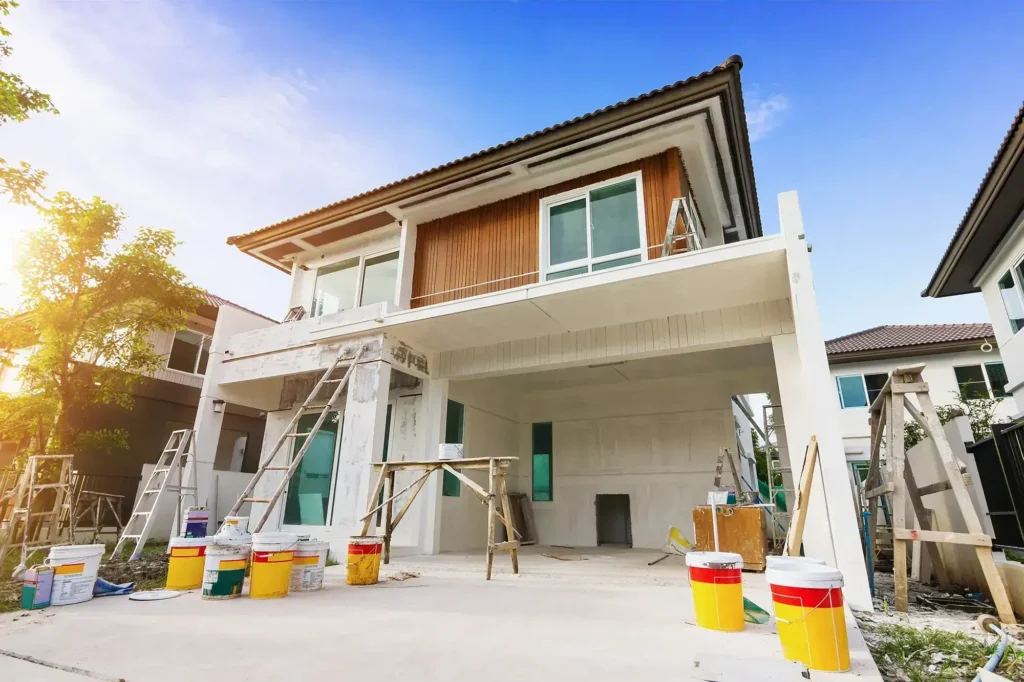Painting the exterior of your house can give it a new look and make it look better from the street. If you want to get professional looking results when painting the exterior of your home, you need to learn how to do it right. This is true whether you just want to touch up the paint or change the whole color scheme. This complete guide will show you all the necessary steps and give you expert advice so you can paint the outside of your home with confidence. We’ll go over everything you need to know to paint the outside of your home, from getting the surface ready and choosing the right paints and supplies to mastering the painting skills and taking care of your investment.

Preparing Your Home for Painting
Getting your house ready to be painted is very important if you want a perfect finish that lasts. If you prepare the area correctly, the paint will stick well, go on smoothly, and work at its best. Preparation work, like checking the outside and cleaning and fixing surfaces, is very important for getting a good paint job that makes your home look better and last longer.
Inspecting the Exterior:
Before you paint, look over the outside of your house carefully for any damage, like cracks, rot, or paint that is coming off. Taking care of these problems early on will give the new paint a stable base and stop problems from happening in the future.
Cleaning the Surface:
A good paint job depends on how clean the area is. Use a power washer or cleaning solution to get rid of dirt, dust, mildew, and other things that are on the surface. This makes sure that the glue sticks well and stops any flaws that could hurt the finish.
Repairing Any Damage:
Fix any flaws or damage on the surface before you paint it. Use the right fillers or glue to fill in cracks, holes, and gaps, and fix wood that is damaged or rotting. Fixing things the right way makes sure the surface is smooth and even so the paint can stick to it.
Protecting Surrounding Areas:
Before you start painting, make sure that the areas around you won’t get sprayed or dripped on. Wrap painter’s tape around windows, doors, furniture, and other things that you don’t want to paint to protect them. Protect outdoor chairs, gardens, and other items from damage by putting something over them.
Gathering Materials and Tools
For painting work to go well, you need to gather materials and tools. Having the right tools, like paint, primer, brushes, and rollers, makes sure that you work quickly and well. To keep yourself safe while painting, you also need to wear the right protective equipment. To speed up the painting process, make sure you have everything you need before you start.
Essential Tools for Painting:
Make sure you have a range of paint trays, brushes, rollers, and extension poles so you can paint different surfaces and parts of your house. Good tools make painting go more smoothly and help you get results that look like they were done by professionals.
Choosing the Right Paint and Primer:
Choose excellent paint and primer that are right for the weather and the material on the outside of your house. Think about things like color retention, durability, and weather resistance to make sure you get a finish that will last and protect and improve the look of your house.
Safety Equipment and Tools:
When dealing with paint or chemicals, it’s especially important to put safety first by wearing goggles, gloves, and a breathing mask. For places that are higher than ground level, use strong ladders or stands and be careful not to hurt yourself while painting.
Supplies for Surface Preparation:
Along with painting tools, you should also get things like brushes, cutters, and cleaning solutions to prepare the surface. Preparing the surface correctly is key to getting a smooth finish and good paint bonding, so don’t forget how important these materials are.

Planning Your Painting Strategy
Planning your painting strategy is very important for getting the job done quickly and well. To speed up the painting process, think about things like the weather, your schedule, the colors you want to use, and how long it will take to prepare the surface. An organized strategy makes sure that everything runs smoothly and helps you get the results you want with as few problems as possible in your daily life.
Selecting the Right Time and Weather Conditions:
For the best paint drying conditions, pick days with warm temperatures and low air. If you don’t want to ruin the quality of your paint job, don’t paint when it’s very hot or cold, raining, or windy.
Creating a Timeline and Schedule:
Make a schedule for each step of the painting process, from preparing the surface to putting the final touches on. Allow enough time for every task, taking into account how long things need to dry, if the weather causes delays, and any other problems that come up that you didn’t expect.
Considering Color Options and Design:
Pick paint colors and design schemes that go well with the building, landscaping, and environment around your home with care. Before making a final choice, try out paint samples and picture how different colors will look in different lights.
Accounting for Surface Preparation:
Think about how much time and money it will take to properly prepare the surface by cleaning, fixing, and painting it. Preparing the surface correctly is the first step to a successful painting work because it ensures that the paint will stick well and leave a smooth finish.
Applying the Paint
Perfect results can only be achieved by carefully applying the paint. Using the right tools, like brushes, rollers, or sprayers, to apply the paint will make sure it covers evenly and lasts a long time. Mastering the right way to apply paint is important for getting results that look professional, improve the look of your home, and protect it from the weather.
Techniques for Brush and Roller Application:
To get smooth, even coverage on siding, trim, doors, and other surfaces, learn the right way to use a brush and a roller, such as how to cut in the sides and roll evenly.
Using Sprayers for Large Surfaces:
Paint sprayers are the fastest and most effective way to cover big, flat surfaces like walls and fences. For an even coat of paint, make sure the spray settings are set correctly and that the lines are always the same.
Achieving Smooth and Even Coats:
Paint should be applied in thin, even coats to avoid drips, runs, and an uneven finish. Methodically work your way from the top to the bottom, overlapping your strokes to make the color blend and fill the whole surface evenly.
Ensuring Proper Drying and Curing:
Follow the manufacturer’s guidelines and give enough time for each coat to dry. To keep the paint from wrinkles, breaking, or sticking together badly, don’t add any more coats until the last one is completely dry. A strong and durable paint finish comes from drying the paint the right way.
Finishing Touches and Cleanup
The last steps in a successful painting work are finishing touches and clean up. Make sure to look over the finished paint work, take off any covers that are there to protect it, and fix any problems that you find. If you clean up after yourself, you’ll have a clean place to work and your painting tools will last longer. Your home will also look nice and new.
Inspecting the Finished Paint work:
Look over the painted areas very carefully to see if there are any flaws, like missed spots, drips, or uneven covering. Take care of any touch-ups that need to be done right away to make sure you get a perfect finish that meets your standards and makes your home look better.
Removing Painter’s Tape and Protection:
When removing painter’s tape and other protected coverings from trim, windows, doors, and other surfaces that can’t be painted, take care. Take your time to avoid damaging recently painted areas, and ensure clean, crisp lines for a professional finish.
Properly Disposing of Paint Waste:
Follow the rules and laws in your area for properly getting rid of paint cans, used brushes, rollers, and other painting supplies. If you can, recycle or donate any leftover paint, and get rid of any dangerous materials properly to have the least amount of effect on the environment.
Cleaning Up Work Area:
Clean and organize your work area completely, getting rid of any trash, spills, or paint that is still there. Brushes, rollers, and other painting tools should be rinsed with water or the right chemicals to get rid of paint waste and make them last longer so they can be used again.
Conclusion:
In conclusion, Painting the exterior of your house isn’t just a way to make it look better it also protects it from the weather. You can get professional quality results that make your home look better and last longer if you do the right research, carefully apply the paint, and pay close attention to the finishing touches and cleanup. Enjoy how a fresh coat of paint can change the look of your home and show off your style and pride in being a homeowner.
